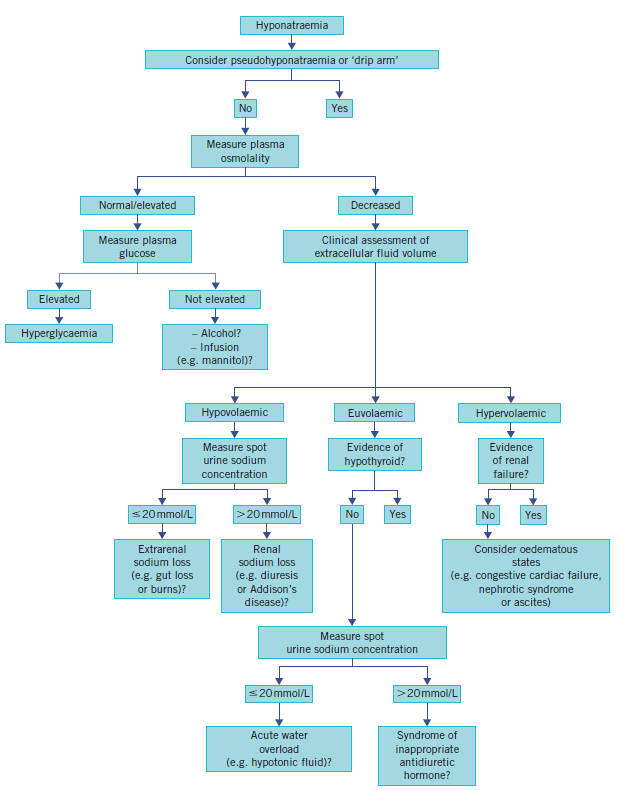Makindo Medical Notes"One small step for man, one large step for Makindo" |
|
|---|---|
| Download all this content in the Apps now Android App and Apple iPhone/Pad App | |
| MEDICAL DISCLAIMER: The contents are under continuing development and improvements and despite all efforts may contain errors of omission or fact. This is not to be used for the assessment, diagnosis, or management of patients. It should not be regarded as medical advice by healthcare workers or laypeople. It is for educational purposes only. Please adhere to your local protocols. Use the BNF for drug information. If you are unwell please seek urgent healthcare advice. If you do not accept this then please do not use the website. Makindo Ltd. |
Hyponatraemia
-
| About | Anaesthetics and Critical Care | Anatomy | Biochemistry | Cardiology | Clinical Cases | CompSci | Crib | Dermatology | Differentials | Drugs | ENT | Electrocardiogram | Embryology | Emergency Medicine | Endocrinology | Ethics | Foundation Doctors | Gastroenterology | General Information | General Practice | Genetics | Geriatric Medicine | Guidelines | Haematology | Hepatology | Immunology | Infectious Diseases | Infographic | Investigations | Lists | Microbiology | Miscellaneous | Nephrology | Neuroanatomy | Neurology | Nutrition | OSCE | Obstetrics Gynaecology | Oncology | Ophthalmology | Oral Medicine and Dentistry | Paediatrics | Palliative | Pathology | Pharmacology | Physiology | Procedures | Psychiatry | Radiology | Respiratory | Resuscitation | Rheumatology | Statistics and Research | Stroke | Surgery | Toxicology | Trauma and Orthopaedics | Twitter | Urology
Related Subjects: | Sodium Physiology | Hyponatraemia | TURP Hyponatraemia syndrome | Hypernatraemia | Diabetes Insipidus
⚠️ Hyponatraemia: A sudden drop in serum sodium (Na⁺) can cause cerebral oedema → cellular swelling, seizures, and coma. 🧠 Severe cases risk brain herniation. ⏳ Chronic/gradual decline is better tolerated. 📈 Correction must be <12 mmol/L per day (ideally 6–8 mmol/L/24h) to avoid Central Pontine Myelinolysis (CPM).
| 🚨 Comatose Management (Severe Hyponatraemia Na <115 mmol/L) |
|---|
|
🧬 Physiology
- Low Na⁺ → suppresses ADH release (normally increases water excretion).
- SIADH → inappropriate ADH secretion → water retention, ↑ urine osmolality.
- Hypovolaemia → ADH & thirst ↑, aldosterone promotes Na reabsorption.
- Result = water shifts intracellularly → cerebral oedema.
📊 Clinical Evaluation
- Check drug history, fluid balance, exam hydration status.
- Hypovolaemic: Dehydrated, dry mucous membranes, hypotension. (Causes: GI losses, Addison’s, burns, diuretics).
- Euvolaemic: Normal exam, SIADH common. (Causes: SSRIs, NSAIDs, post-op, pain, stress, psychogenic polydipsia).
- Hypervolaemic: Oedema, ascites, HF, CKD, cirrhosis, iatrogenic fluids, post-TURP syndrome.
🧾 Causes of Hyponatraemia
- Hypovolaemic: GI losses, diuretics, Addison’s, salt-wasting nephropathy.
- Euvolaemic: SIADH, drugs, pain, stress, post-TURP, psychogenic polydipsia.
- Hypervolaemic: HF, CKD, cirrhosis, iatrogenic fluids.
- Pseudohyponatraemia: Hyperlipidaemia or hyperproteinaemia → lab artefact.
📉 Severity & Symptoms
- 🔺 Rapid fall or Na <120 mmol/L → symptomatic risk ↑.
- Na 110–115 → headache, confusion, irritability.
- Na <110 → seizures, coma, ataxia (medical emergency).
🔬 Investigations
- 🧪 U&E: Mild (135–130), Moderate (125–129), Severe (<125).
- 🧪 Serum Osmolality: <275 in true hypoNa.
- 🧪 Urine Osmolality: >100 in SIADH.
- 🧪 Urine Na: <20 in hypovolaemia, >30 in SIADH.
- 🔎 TFTs & Cortisol (exclude hypothyroid/adrenal insufficiency).
- 📷 CXR (lung cancer, pneumonia → SIADH).
- 🧠 CT Head (exclude bleed, tumour, infection).

⚠️ Central Pontine Myelinolysis (CPM)
🧠 Risk of overly rapid correction of chronic hypoNa → demyelination (esp. pons). ➡️ Irreversible deficits: dysarthria, quadriplegia, locked-in syndrome. ⛔ Keep correction ≤12 mmol/L/day.
📈 Algorithm
🩺 Management Principles
- ✅ ABC first. Admit severe cases to HDU/ITU.
- 🔄 Frequent Na checks (2–4h), strict fluid balance.
- 💉 Hypovolaemia: IV normal saline → reassess.
- 🚰 SIADH/Euvolaemia: Fluid restrict (800–1000 ml/day). In seizures/coma → 3% saline bolus (~5 mmol/L correction).
- 💊 Persistent SIADH: Tolvaptan or Demeclocycline.
- 🧾 Addison’s: Short Synacthen Test → IV hydrocortisone.
- 🌊 Hypervolaemic: Restrict salt & water, loop diuretics if needed.
📚 References
- Diagnosis & Management of Inpatient Hyponatraemia and SIADH
- Guidelines for Hyponatraemia Management (RLBUHT)
🩺 Case 1 — Hypovolaemic Hyponatraemia
A 72-year-old woman presents with vomiting and diarrhoea for 4 days. She is confused, BP 90/60 mmHg, pulse 110 bpm, mucous membranes dry. Labs: Na⁺ 124 mmol/L, urea and creatinine raised. Management: 💧 IV 0.9% saline cautiously to restore volume, monitor sodium rise. Identify and treat cause (e.g. gastroenteritis). Avoid: ❌ Rapid correction (>8–10 mmol/L per 24 h) as this risks osmotic demyelination syndrome (ODS).
🩺 Case 2 — Euvolaemic Hyponatraemia (SIADH)
A 68-year-old man with a history of small-cell lung cancer presents with confusion and seizures. He is euvolaemic on exam. Labs: Na⁺ 116 mmol/L, low plasma osmolality, inappropriately concentrated urine. Management: 🚰 Fluid restriction, consider demeclocycline or vasopressin receptor antagonists in refractory cases; treat underlying cause (e.g. lung cancer). Hypertonic saline in severe symptomatic cases under specialist care. Avoid: ❌ Isotonic saline — may worsen hyponatraemia in SIADH. Avoid rapid correction.
🩺 Case 3 — Hypervolaemic Hyponatraemia
An 80-year-old man with decompensated heart failure presents with breathlessness, ankle swelling, and Na⁺ 128 mmol/L. Exam shows raised JVP, pitting oedema, bibasal crackles. Management: 💊 Fluid and salt restriction, loop diuretics, optimise heart failure therapy (ACEI/ARNI, beta-blocker, MRA). Avoid: ❌ Rapid overcorrection; avoid excessive IV fluids which worsen overload.